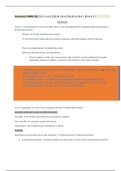Summary MCRS 2b [ §1.1-1.6.2 | §1.8-1.8.4 | §1.8.5-1.8.6 | §5.4-5.5 ]
Methods
Theory = an explanation or set of principles that is well substantiated by repeated testing and explains a
broad phenomenon
Theories data collection and analysis
Theories lead to data collection/analysis and Data collection/analysis informs theories
Theory and Hypotheses explain the world
Difference between theory and hypothesis
- Theory explains a wide set of phenomena with small set of well-established principles
- Hypothesis (seeks to) explains a narrower phenomenon and is (yet) untested
- HYPOTHESIS IS A EXPLANTORY STATEMENT ABOUT SOMETHING BUT NOT
OBSERVABLE ITSELF.
- THE PREDICTION IS NOT THE HYPOTHESIS
- THE PREDICTION = SOMETHING DERIVED FROM HYPOTHESIS THAT
OPERATIONALIZES IT SO YOU CAN OBSERVE THINGS THAT HELP YOU
DETERMINE THE PLAUSIBLITY OF THE HYPOTHESIS
To test hypothesis move from conceptual domain to observable domain
Scientific statement vs non scientific statement
Scientific be verified with reference to empirical evidence
Non scientific cannot be empirically tested
Falsification = Act of disproving a hypothesis or theory
Variables
Hypotheses can be expresses in two variables: 1. Proposed cause 2. Proposed outcome
1. Independent variable = variable thought to be the cause of some effect. Experimental research
, 2. Dependent variable =Variable thought to be affected by changes in an independent variable.
Aka outcome
1. Predictor variable = synonym to independent variable, predict an outcome variable
2. Outcome variable = synonym to dependent variable, change as a function of changes in a
predictor variable
In experimental work cause = preditor ; effect = outcome
Related to measurement
Type of categorical variable binary variable
Ex. Dead or alive, male or female
Nominal variable two things equivalent in some sense are given the same name but there are more
than 2 possibilities
Continuous variable measure any level of precision
Discrete variable take certain values
Continuous measured as Discrete
Ex. We measure age by using years and not including nanoseconds
Discrete measured as Continuous
Ex. Number of boyfriends you have is a discrete variable. When for example the magazine
says that the average amount of boyfriends women have in their 20s is 4,6. The variable is
continuous eventhough the averages are meaningless.
Measurement-related issues that could occur:
1. Different sample ( amount, distribution)
2. Different method of measurement
Self report measures larger measurement error because factors than the one you’re trying to
measure will influence how people respond to our measures
Level of measurement
1. Categorical (entities are divided into distinct categories):
- Binary variable: There are only two categories (e.g., dead or alive).
- Nominal variable: There are more than two categories (e.g.,
whether someone is an omnivore, vegetarian, vegan, or fruitarian).
- Ordinal variable: The same as a nominal variable but the categories
, have a logical order (e.g., whether people got a fail, a pass, a merit
or a distinction in their exam).
2. Continuous (entities get a distinct score):
- Interval variable: Equal intervals on the variable represent equal
differences in the property being measured (e.g., the difference
between 6 and 8 is equivalent to the difference between 13 and
15).
- Ratio variable: The same as an interval variable, but the ratios of
scores on the scale must also make sense (e.g., a score of 16 on an
anxiety scale means that the person is, in reality, twice as anxious as
someone scoring 8). For this to be true, the scale must have a
meaningful zero point.
Validity and reliability
Validity = refers whether an instrument measures what it was designed to measure
- Data recorded simultaneously using the new instrument and existing criteria said to
assess concurrent validity
- Data used to predict observations at a later point in time said to assess predictive
validity
Reliability = ability of the measure to produce the same results under the same circumstances
- Test the same group of people twice
, Statistics
Normal distribution bell shape
Deviation of distribution
1. Skew – lack of symmetry
- Positively skewed: frequent scores
clustered at the lower end
- Negatively skewed: frequent scores
cluster at higher end
2. Kurtosis – pointiness
- Positive kurtosis (leptokurtic): many scores in the tails and pointy
- Negative kurtosis (platykurtic): thin in
the tails flatter than normal
The mode
Score that occurs most frequently
Calculate:
1. Place data in ascending order
2. Count how many times each score occurs
3. Most occurring score = mode
The median
Middle score when scores are ranked in order of magnitude
Calculate:
1. Place data in ascending order
2. Find position of the middle score (n)
3. Add one to this value – (n+1)
4. Divide by 2 – (n+1)/2
Valid for uneven numbers of scores
! for even number of scores see below
Ex. 22, 40, 53, 57, 93, 98, 103, 108, 116, 121
1. Add up two middle scores - 93 and 98 are the middle (93+98)
2. Divide by 2 – (93+98)/2 = 95,5
3. Median = 95,5
Characteristics:
- Unaffected by extreme scores
- Relatively unaffected by skewed distribution






